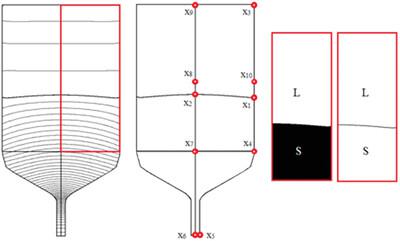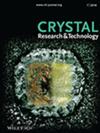VGF晶体生长配方的发展:利用图像和数值数据智能解决不适定反问题
IF 1.9
4区 材料科学
Q3 CRYSTALLOGRAPHY
引用次数: 1
摘要
冻结晶体垂直生长过程的发展是解决病态逆问题的一个典型例子,它违反了Hadamard解的存在性、唯一性和稳定性的一个或多个适定准则。在本研究中,采用了不同的数据驱动方法来解决反问题:基于逆距离加权的适当正交分解的降阶建模方法(ROM POD InvD), Kriging和人工神经网络(ANN)的近似方法,分别采用图像,图像和数值数据的组合以及单独的数值数据。约200个训练数据由计算流体动力学(CFD)模拟正演问题生成。数值输入数据与熔体和晶体中10个特征监测点的温度和坐标有关,图像输入数据与界面形状和位置有关。与仅基于图像的ROM POD InvD方法相比,以随机均方误差为标准,基于图像和数值数据的Kriging方法和基于数值数据的ANN方法能够更准确地捕捉系统行为。本文章由计算机程序翻译,如有差异,请以英文原文为准。

Development of the VGF Crystal Growth Recipe: Intelligent Solutions of Ill‐Posed Inverse Problems using Images and Numerical Data
Development of the Vertical Growth Freeze crystal growth process is a typical example of solving the ill‐posed inverse problem, which violates one or more of Hadamard's well‐posedness criteria of solution existence, uniqueness, and stability. In this study, different data‐driven approaches are used to solve inverse problems: Reduced Order Modelling method of Proper Orthogonal Decomposition with Inverse Distance weighting (ROM POD InvD), an approximation method of Kriging and Artificial Neural Networks (ANN) employing images, combination of images and numerical data and solely numerical data, respectively. The ≈200 training data are generated by Computational Fluid Dynamics (CFD) simulations of the forward problem. Numerical input data are related to the temperatures and coordinates in 10 characteristic monitoring points in the melt and crystal, while the image input data are related to the interface shape and position. Using the random mean squared error as a criterion, the Kriging method based on images and numerical data and the ANN method based on numerical data are able to capture the system behavior more accurately, in contrast to the ROM POD InvD method, which is based solely on images.
求助全文
通过发布文献求助,成功后即可免费获取论文全文。
去求助
来源期刊
自引率
6.70%
发文量
121
审稿时长
1.9 months
期刊介绍:
The journal Crystal Research and Technology is a pure online Journal (since 2012).
Crystal Research and Technology is an international journal examining all aspects of research within experimental, industrial, and theoretical crystallography. The journal covers the relevant aspects of
-crystal growth techniques and phenomena (including bulk growth, thin films)
-modern crystalline materials (e.g. smart materials, nanocrystals, quasicrystals, liquid crystals)
-industrial crystallisation
-application of crystals in materials science, electronics, data storage, and optics
-experimental, simulation and theoretical studies of the structural properties of crystals
-crystallographic computing

 求助内容:
求助内容: 应助结果提醒方式:
应助结果提醒方式:


